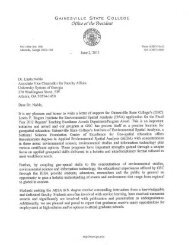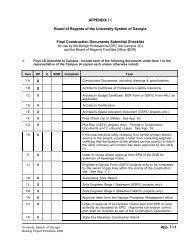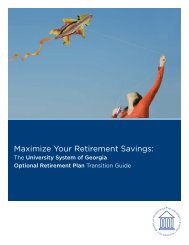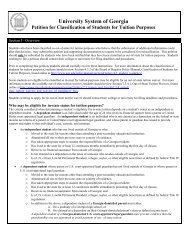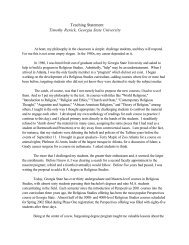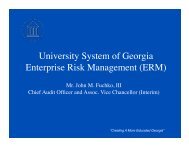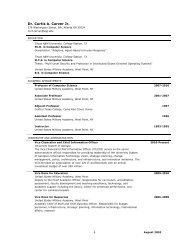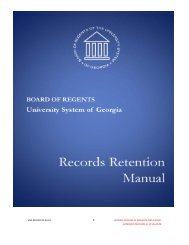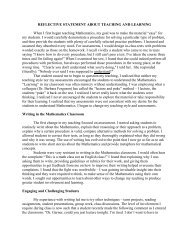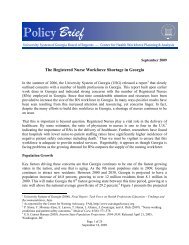66916 Federal Register / Vol. 75, No. 209 / Friday, October 29, 2010 / Rules and RegulationsWReier-Aviles on DSKGBLS3C1PROD with RULES2Changes: None.Comment: Some commentersexpressed concern with the effect theseproposed misrepresentation regulationscould have on students. They arguedthat the regulations would conflict withState laws and create confusion in anarea long regulated by the States. Forexample, given that students filecomplaints with the State, thecommenters stated that an additionalFederal remedy would be duplicativeand would create uncertainty forstudents.Other commenters expressed concernabout institutions that require studentsto sign arbitration and confidentialityagreements as part <strong>of</strong> their enrollmentcontracts. These agreements serve tolimit access to qualified legal counselfor students who may want to pursue amisrepresentation claim. Somecommenters stated that the regulationsshould not be interpreted to create anexpress or implied private right <strong>of</strong>action against an institution formisrepresentation.Discussion: We disagree with thecommenters who stated that studentswill be confused by themisrepresentation regulations becausethey otherwise typically pursue claims<strong>of</strong> misrepresentation under State law.Nothing in the proposed regulationsalters a student’s ability to pursueclaims <strong>of</strong> misrepresentation pursuant toState law and nothing in the proposedregulations creates a new Federalprivate right <strong>of</strong> action. The regulationsare intended to make sure thatinstitutions are on notice that the<strong>Department</strong> believes thatmisrepresentations constitute a seriousviolation <strong>of</strong> the institutions’ fiduciaryduty and that the <strong>Department</strong> willcarefully and fairly evaluate claims <strong>of</strong>misrepresentation before determining anappropriate course <strong>of</strong> action.Changes: None.Scope and Special Definitions (§ 668.71)Comment: Many commentersexpressed concern about the expansion<strong>of</strong> the misrepresentation regulations tocover false or misleading statementsmade by representatives <strong>of</strong> theinstitution or any ineligible institution,organization or person with whom theinstitution has an agreement. Thecommenters believed that this changewill result in holding institutionsaccountable for what is said, may besaid, or inadvertently is said, byindividuals or organizations that mayhave no <strong>of</strong>ficial connection to aninstitution, and that institutions cannotmonitor inadvertent and un<strong>of</strong>ficialcomments. Commenters argued that theproposals would expose goodinstitutions to sanctions based onactions beyond their control. Manycommenters sought clarification aboutwhich representatives <strong>of</strong> the institutionare covered by the regulations. Forexample, commenters pointed tostatements that may be made bystudents through the use <strong>of</strong> socialmedia. One commenter suggested wemodify the definition <strong>of</strong>misrepresentation to clarify thatinstitutions are responsible forstatements made by representatives orentities compensated by the institution.Another commenter recommended thatwe include only individuals under thedirect control <strong>of</strong> the institution,including spokespersons andenrollment management companies.We received another suggestion tolimit covered agreements to thoserelating to marketing or admissions.Many commenters expressed concernthat, without this change, the proposedregulations would apply to thehundreds <strong>of</strong> contracts a large institutionmay have with various vendors andservice providers. They suggested thatthe institution only be responsible forcommunications from and statements byindividuals or entities authorized tospeak for the institution or who haverepresentative authority to respond tothe subject in question.Commenters were particularlyconcerned about the penalties thatcould result from misinformationprovided by an entity other than theinstitution. The commenters argued thatthe institution should not be subjectedto undue penalties if the institution tooksteps to monitor and mitigate suchpossible misrepresentations, and in fact,took action upon identifying anyincidences. For example, institutionsprovide information to companies thatcompile college rankings that are <strong>of</strong>tenderided as inaccurate, incomplete orfalse. Commenters believed that anypenalties should be limited tostatements related to the relationshipbetween the institution and the entity.Discussion: As noted elsewhere inthis preamble, the <strong>Department</strong> enforcesits regulations, including those insubpart F <strong>of</strong> part 668 within a rule <strong>of</strong>reasonableness. We strongly believe thatthe concerns voiced by manycommenters have ignored this fact. Wedo not expect, for example, to findactionable violations in the commentsmade by students and routine vendors.However, the <strong>Department</strong> acknowledgesthat the language in § 668.71 may beunnecessarily broad. For this reason, weagree to limit the reach <strong>of</strong> the ban onmaking substantial misrepresentationsto statements made by any ineligibleinstitution, organization, or person withVerDate Mar2010 14:10 Oct 28, 2010 Jkt 223001 PO 00000 Frm 00086 Fmt 4701 Sfmt 4700 E:\FR\FM\29OCR2.SGM 29OCR2whom the eligible institution has anagreement to provide educationalprograms or those that providemarketing, advertising, recruiting, oradmissions services. We have done thisby narrowing the language in § 668.71(b)and the definition <strong>of</strong> the termmisrepresentation. As a result,statements made by students throughsocial media outlets would not becovered by these misrepresentationregulations. Also, statements made byentities that have agreements with theinstitution to provide services, such asfood service, other than educationalprograms, marketing, advertising,recruiting, or admissions services wouldnot be covered by thesemisrepresentation regulations.Changes: We have revised § 668.71(b)and the definition <strong>of</strong> the termmisrepresentation in § 668.71(c) toclarify that the ban onmisrepresentations for which aninstitution is responsible only extendsto false, erroneous, or misleadingstatements about the institution that aremade by an ineligible institution,organization, or persons with whom theinstitution has an agreement to provideeducational programs or to providemarketing, advertising, recruiting, oradmissions services.Comment: Some commenters noted aneed for the regulations to clearlydifferentiate between‘‘misrepresentation’’ and ‘‘substantialmisrepresentation.’’ Other commentersquestioned how we will determine whatconstitutes ‘‘substantialmisrepresentation.’’ These commentersasked what the standards are fordetermining what constitutes harm,materiality, or intent to misrepresent.Another commenter suggested that werevise the definition <strong>of</strong> substantialmisrepresentation to includemisrepresentations that aredisseminated—not only those that are‘‘made’’.Discussion: The <strong>Department</strong> iscomfortable with its ability to make thedistinction between a misrepresentationand a substantial misrepresentation. Webelieve that the regulatory definitionswe are establishing are clear and caneasily be used to evaluate allegedviolations <strong>of</strong> the regulations. Moreover,as previously stated, we routinelyevaluate the seriousness <strong>of</strong> title IV, HEAprogram violations before determiningwhat, if any, action is appropriate.There is nothing in the proposedmisrepresentation regulations that willalter the manner in which the<strong>Department</strong> reviews any violation <strong>of</strong>part 668, subpart F before deciding howit should respond.Changes: None.
Federal Register / Vol. 75, No. 209 / Friday, October 29, 2010 / Rules and Regulations66917WReier-Aviles on DSKGBLS3C1PROD with RULES2Comment: Some commenterssupported the proposed definition <strong>of</strong>misrepresentation in § 668.71(c), which,as applied in these regulations,prohibits making false, erroneous, ormisleading statements directly orindirectly to students, prospectivestudents, or any member <strong>of</strong> the public,an accrediting agency, a State agency orthe Secretary. They stated that thesechanges provide much needed updatesto the current regulations and that theremedies give the <strong>Department</strong> neededflexibility. The commenters noted thatthe <strong>Department</strong> should not tolerateinstitutions that knowinglymisrepresent facts and providemisinformation on purpose to students,their families and the public, and thatwe should hold institutions accountablethat encourage students to enroll but failto deliver on statements regardingaccreditation and employability.Other commenters expressed concernabout broadening the list <strong>of</strong> entities towhich an institution may not make afalse, erroneous, or misleadingstatement to include accreditingagencies, State agencies or any member<strong>of</strong> the public. These commentersremarked that the effect <strong>of</strong> thisregulatory change is that the list nowincludes anyone. The commentersargued that the determination <strong>of</strong>whether an institution has mademisleading statements to an accreditingagency or State agency should be madeby that agency, not the <strong>Department</strong>, andthat the agency should take appropriateaction. One commenter suggested thatthe list <strong>of</strong> entities should also includeparents who may be signing orcosigning loans.Discussion: The <strong>Department</strong> believesthat in its stewardship <strong>of</strong> the title IV,HEA programs, it is essential to monitorthe claims made by institutions not onlyto students and prospective students,but also those made to the <strong>Department</strong>’spartners who help maintain the integrity<strong>of</strong> these programs. While it is likely thatother oversight agencies will respondappropriately to any substantialmisrepresentations that are made tothem, only the <strong>Department</strong> has theoverall responsibility for preserving thepropriety <strong>of</strong> the administration <strong>of</strong> thetitle IV, HEA programs.In addition, because parents are alsomembers <strong>of</strong> the public, and most, if notall, statements made to them will alsobe made to students or prospectivestudents, the <strong>Department</strong> does notbelieve that further enumeration toinclude parents is necessary.Changes: None.Comment: Some commenters notedthat the term ‘‘misleading statement’’ isnot defined by the FTC, and opinedthat, because the term’s definitionmerely reiterates what has always beenrequired for a finding <strong>of</strong> a substantialmisrepresentation, it is unnecessary forthe <strong>Department</strong> to define the term in itsregulations. Some commenterssuggested that, instead, the <strong>Department</strong>follow the FTC’s practice <strong>of</strong>acknowledging that a finding <strong>of</strong>misrepresentation is a fact-specificinquiry based on a flexible standard.Many commenters appeared to beparticularly concerned about the use <strong>of</strong>the phrase ‘‘capacity, likelihood, ortendency to deceive or confuse’’ in thedescription <strong>of</strong> a ‘‘misleading statement’’.Some commenters stated that they donot believe that an enforceable ordefensible basis for misrepresentation iscreated by including the likelihood <strong>of</strong>any form <strong>of</strong> communication to confuseor ‘‘have the capacity’’ to confuse astudent or potential student. Onecommenter suggested we clarify that inorder to constitute misrepresentation,the statement must have the ‘‘capacity ortendency’’ to deceive or confuse and be‘‘likely’’ to deceive or confuse. Thecommenter cited examples <strong>of</strong> statementsfrequently made in marketing materialsby institutions, such as ‘‘there is a placefor everyone at XYZ.’’ Other commentersnoted that institutions provideinformation on a variety <strong>of</strong> complexissues that students and others may findconfusing. In particular, certain terms <strong>of</strong>art such as ‘‘cost <strong>of</strong> attendance’’ and‘‘graduation rate’’ may not be familiar tothe general public and may be confusingto them. Another commenter requestedthat we clarify that a misrepresentationis not made if confusion results from theaccurate reporting <strong>of</strong> disclosuresrequired under various laws.These commenters expressed concernthat attempts to comply with recentlypromulgated regulations on college cost,transparency, and outcomes measuresmay result in confusion and lead toreported complaints <strong>of</strong>misrepresentation.Several commenters argued that the<strong>Department</strong> needs to address the issue<strong>of</strong> misrepresentation through omissions<strong>of</strong> important information. Onecommenter suggested that we addlanguage in the description <strong>of</strong> the termmisleading statement to include anomission, if in the absence <strong>of</strong> anaffirmative disclosure is likely to resultin a person assuming something that isincorrect.One commenter stated that oralstatements should not be included inthe definition <strong>of</strong> misrepresentation. Thecommenter questioned how the<strong>Department</strong> would know that an oralmisleading statement was made.VerDate Mar2010 14:10 Oct 28, 2010 Jkt 223001 PO 00000 Frm 00087 Fmt 4701 Sfmt 4700 E:\FR\FM\29OCR2.SGM 29OCR2Many commenters expressed concernthat the proposed misrepresentationregulations will restrict their capabilityto use the Internet for fear <strong>of</strong>misrepresentation. These commentersnoted that their top lead source is theInternet and that Internet marketing isthe bloodline <strong>of</strong> all institutions. Thecommenters also pointed out thatInternet marketing has issues relating todomain name ownership, nameconfusion, and pirating, and that, whenthe <strong>Department</strong> enforces theseregulations, it needs to be careful inensuring that it has the correctinstitution.Discussion: The <strong>Department</strong> believesthat it is appropriate to define the termmisrepresentation in its regulations inorder to distinguish misrepresentationfrom substantial misrepresentation. Asdiscussed elsewhere in this preamble,the <strong>Department</strong> agrees that determiningwhether a misrepresentation has beenmade should be accomplished througha fact-specific inquiry and thatenforcement actions should only bebrought when reasonable.With regard to the comments whostated that the ‘‘capacity, likelihood, ortendency to deceive or confuse’’language will be confusing, we have noreason to believe that this language willhave any such effect. Moreover, we donot believe that it is necessary to revisethe regulations to state that a misleadingstatement must have both the capacityor tendency and likelihood to deceivebecause we believe that a statement thathas any <strong>of</strong> the characteristics <strong>of</strong> thecapacity, likelihood, or tendency todeceive or confuse is misleading.By adopting these proposedregulations, the <strong>Department</strong> is notseeking to create extraneous bases uponwhich it can initiate enforcementactions. Rather, we want to ensure thatthe regulations help, rather than hinder,our ability to protect students,prospective students, and others frommisleading statements made about aneligible institution, the nature <strong>of</strong> itseducational program, its financialcharges, or the employability <strong>of</strong> itsgraduates. The <strong>Department</strong> believes itcan be trusted to properly evaluatewhether a claim is confusing to a degreethat it becomes actionable. It is alsoimportant to remember that it is onlysubstantial misrepresentations that riseto the level where the <strong>Department</strong> maycontemplate action.As far as the failure <strong>of</strong> the proposedregulations to address affirmativeomissions, the <strong>Department</strong> believes thatthe purpose <strong>of</strong> these regulations is tomake sure that all statements aninstitution makes are truthful.Separately, the <strong>Department</strong> requires an
- Page 1 and 2:
Friday,October 29, 2010Part IIDepar
- Page 3 and 4:
Federal Register / Vol. 75, No. 209
- Page 6 and 7:
66836 Federal Register / Vol. 75, N
- Page 8 and 9:
66838 Federal Register / Vol. 75, N
- Page 10 and 11:
WReier-Aviles on DSKGBLS3C1PROD wit
- Page 12 and 13:
66842 Federal Register / Vol. 75, N
- Page 14 and 15:
66844 Federal Register / Vol. 75, N
- Page 16 and 17:
WReier-Aviles on DSKGBLS3C1PROD wit
- Page 18 and 19:
66848 Federal Register / Vol. 75, N
- Page 20 and 21:
66850 Federal Register / Vol. 75, N
- Page 22 and 23:
WReier-Aviles on DSKGBLS3C1PROD wit
- Page 24 and 25:
66854 Federal Register / Vol. 75, N
- Page 26 and 27:
WReier-Aviles on DSKGBLS3C1PROD wit
- Page 28 and 29:
66858 Federal Register / Vol. 75, N
- Page 30 and 31:
66860 Federal Register / Vol. 75, N
- Page 32 and 33:
66862 Federal Register / Vol. 75, N
- Page 34 and 35:
66864 Federal Register / Vol. 75, N
- Page 36 and 37: 66866 Federal Register / Vol. 75, N
- Page 38 and 39: WReier-Aviles on DSKGBLS3C1PROD wit
- Page 40 and 41: WReier-Aviles on DSKGBLS3C1PROD wit
- Page 42 and 43: 66872 Federal Register / Vol. 75, N
- Page 44 and 45: WReier-Aviles on DSKGBLS3C1PROD wit
- Page 46 and 47: WReier-Aviles on DSKGBLS3C1PROD wit
- Page 48 and 49: WReier-Aviles on DSKGBLS3C1PROD wit
- Page 50 and 51: 66880 Federal Register / Vol. 75, N
- Page 52 and 53: WReier-Aviles on DSKGBLS3C1PROD wit
- Page 54 and 55: 66884 Federal Register / Vol. 75, N
- Page 56 and 57: 66886 Federal Register / Vol. 75, N
- Page 58 and 59: WReier-Aviles on DSKGBLS3C1PROD wit
- Page 60 and 61: WReier-Aviles on DSKGBLS3C1PROD wit
- Page 62 and 63: WReier-Aviles on DSKGBLS3C1PROD wit
- Page 64 and 65: WReier-Aviles on DSKGBLS3C1PROD wit
- Page 66 and 67: WReier-Aviles on DSKGBLS3C1PROD wit
- Page 68 and 69: WReier-Aviles on DSKGBLS3C1PROD wit
- Page 70 and 71: WReier-Aviles on DSKGBLS3C1PROD wit
- Page 72 and 73: 66902 Federal Register / Vol. 75, N
- Page 74 and 75: WReier-Aviles on DSKGBLS3C1PROD wit
- Page 76 and 77: WReier-Aviles on DSKGBLS3C1PROD wit
- Page 78 and 79: 66908 Federal Register / Vol. 75, N
- Page 80 and 81: WReier-Aviles on DSKGBLS3C1PROD wit
- Page 82 and 83: 66912 Federal Register / Vol. 75, N
- Page 84 and 85: WReier-Aviles on DSKGBLS3C1PROD wit
- Page 88 and 89: WReier-Aviles on DSKGBLS3C1PROD wit
- Page 90 and 91: WReier-Aviles on DSKGBLS3C1PROD wit
- Page 92 and 93: WReier-Aviles on DSKGBLS3C1PROD wit
- Page 94 and 95: 66924 Federal Register / Vol. 75, N
- Page 96 and 97: WReier-Aviles on DSKGBLS3C1PROD wit
- Page 98 and 99: 66928 Federal Register / Vol. 75, N
- Page 100 and 101: WReier-Aviles on DSKGBLS3C1PROD wit
- Page 102 and 103: 66932 Federal Register / Vol. 75, N
- Page 104 and 105: WReier-Aviles on DSKGBLS3C1PROD wit
- Page 106 and 107: 66936 Federal Register / Vol. 75, N
- Page 108 and 109: 66938 Federal Register / Vol. 75, N
- Page 110 and 111: 66940 Federal Register / Vol. 75, N
- Page 112 and 113: 66942 Federal Register / Vol. 75, N
- Page 114 and 115: 66944 Federal Register / Vol. 75, N
- Page 116 and 117: 66946 Federal Register / Vol. 75, N
- Page 118 and 119: WReier-Aviles on DSKGBLS3C1PROD wit
- Page 120 and 121: WReier-Aviles on DSKGBLS3C1PROD wit
- Page 122 and 123: WReier-Aviles on DSKGBLS3C1PROD wit
- Page 124 and 125: 66954 Federal Register / Vol. 75, N
- Page 126 and 127: WReier-Aviles on DSKGBLS3C1PROD wit
- Page 128 and 129: 66958 Federal Register / Vol. 75, N
- Page 130 and 131: 66960 Federal Register / Vol. 75, N
- Page 132 and 133: WReier-Aviles on DSKGBLS3C1PROD wit
- Page 134 and 135: WReier-Aviles on DSKGBLS3C1PROD wit
- Page 136 and 137:
WReier-Aviles on DSKGBLS3C1PROD wit
- Page 138 and 139:
66968 Federal Register / Vol. 75, N
- Page 140 and 141:
66970 Federal Register / Vol. 75, N
- Page 142 and 143:
66972 Federal Register / Vol. 75, N
- Page 144 and 145:
66974 Federal Register / Vol. 75, N



